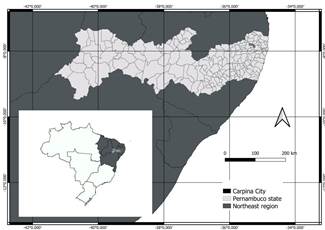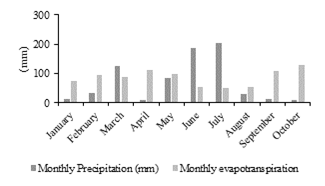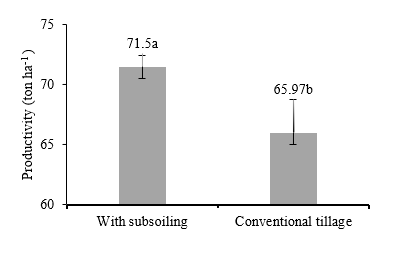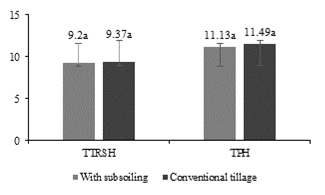1. Introduction
Sugarcane is widely grown in Brazil, and its importance is evident from both a social and economic point of view. In Brazil, the generation of jobs in the sugar energy chain until the second half of 2021 approached 554.78 thousand jobs in the field; in the sugar industry, this value was 197.22 thousand [1]. For the Northeast region, it is estimated that at the end of the 2021/2022 harvest, there were approximately 109.29 thousand direct jobs [2].
According to the third harvest survey [3], the planted area in Brazil is approximately 8264.4 thousand hectares, which should represent, at the end of the 2021/2022 harvest, 568.4 million tonnes of processed cane, which, although high, points to a reduction of 13.2% compared to the previous crop. The northeast region of Brazil, with approximately 733.8 thousand hectares planted, has a production of 43.7 million tonnes of cane, which represents a reduction of 9.7% compared to the 2020/2021 harvest. In the state of Pernambuco, the expected reduction is 41.5%, with a production of 6.9 million tonnes in an estimated area of 134 thousand hectares. These reductions are due to the low rainfall that occurred in several producing regions of the country.
According to [4-6], the total annual precipitation in the northeast region varies from 2500 mm to values lower than 500 mm, which have been recorded in areas mainly between the state of Bahia and the state of Pernambuco. In the state of Pernambuco, two extremes can be observed: the sertão mesoregion, with accumulated rainfall of less than 800 mm [7], and the mesoregion of the forest area, with values ranging from 1400 to 2100 mm [8]. According to [9], sugarcane needs, on average, 1500 to 2500 mm of rain that is evenly distributed throughout the cycle for good development.
Even with the trend of favorable rainfall in the mesoregion of the Zona da Mata of Pernambuco at the end of the 2020/2021 harvest, according to [3], the beginning of the crop cycle was not favored by the climate, considering that regular rain occurred only between April and September.
The production reduction caused by the water deficit strengthens the importance of adopting irrigation methods that allow the rational management of water resources, aiming to minimize the negative impacts of this climatic adversity on agricultural production and favor gains in crop yield. [10] stated that irrigation management is of paramount importance for the growth, development, and increase of crop productivity so that the water deficit has a great influence on agronomic yield. According to [11], in the northeast region, the use of irrigation in the cultivation of sugarcane has been essential to reduce the risks of productivity losses caused by drought, in addition to obtaining better agricultural indicators, which are predominantly used in the conventional sprinkler and drip systems.
Thus, it is important to emphasize that the rational management of water resources aimed at agricultural production must consider soil quality since it is the main vehicle for transporting water to plants in conventional crops. According to [12], soil quality is a combination of physical, chemical, and biological properties that contributes to understanding the limitations of each soil.
[13] observed that the agricultural use of cultivated areas promoted changes in the physical attributes of the soil, negatively influencing physical quality. According to [14] and [15], soil management can modify density and porosity, directly influencing drainage, aeration, and water retention capacity in the profile. Another attribute conducive to changes due to cultivation is the resistance of the soil to root penetration, which is associated with soil compaction and compromises plant development [12].
According to [14], conventional soil management during the sugarcane cycle causes changes in the physical quality of the soil and can consequently disadvantage the root growth of the crop. [16] evaluated the root development of sugarcane using different soil management methods and verified the occurrence of shallow roots in conventional management, while deep soil preparation provided an increase in root growth.
Therefore, it is necessary to adopt practices and management that aim to improve the physical soil properties, mainly minimizing the negative effects of compaction over successive cycles of sugarcane, and thus obtain conditions that favor the efficient management of water resources, absorption of nutrients, and the best development and yield of the crop.
In this context, subsoiling is a practice that shows promise in the search for minimizing the negative impacts on the physical quality of the soil resulting from the compaction caused by conventional cultivation and on the consequent parameters of crop productivity. [17] conceptualized subsoiling as an operation of reduced soil preparation that offers better conditions for plant development and is used to break up compacted layers at depths greater than 0.40 cm. [18] verified that subsoiling in cohesive soil made it possible to reduce soil density and soil penetration resistance, in addition to increasing soil porosity and hydraulic conductivity.
Thus, this study aimed to evaluate the effects of subsoiling between the planting rows of sugarcane ratoon after the 2nd cut on productivity and technological quality through production per hectare (TSH) and measurement of the percentage of apparent sucrose per hectare (TPH) and total recoverable sugar in tonnes per hectare (TTRSH) in an experimental area in the northeast region of Brazil.
2. Materials and methods
This research was carried out in an area belonging to the Sugarcane Experimental Station of Carpina (EECAC), of the Rural Federal University of Pernambuco (UFRPE), located in the city of Carpina-PE, in the mesoregion of Zona da Mata, latitude 7° 51’ 13” S, longitude 35° 14’ 10” W and altitude of 180 m (Fig. 1). The trial period was from January to October 2015, covering the 3rd agricultural cycle of sugarcane established in the area since 2012. The climate of the mesoregion is classified, according to Köppen, as Ams, a tropical rainy monsoon, with a dry summer and an annual average of more than 1500 mm of rainfall associated with temperatures ranging from 21.4 to 25.8°C throughout the year [8].

Source: The authors.
Figure 1 Location map of the city of Carpina, Pernambuco, in the northeast region of Brazil.
The predominant class of soil is Ultisol Typic Fragiudult according to U.S. Soil Taxonomy [19], whose chemical and physical characterization are presented in Table 1.
Table 1. Chemical and physical characterization of the soil.
| Prof (cm) | Chemical analysis | |||||||
|---|---|---|---|---|---|---|---|---|
| pH | P | H+ | Al3+ | Ca2+ | Mg2+ | K+ | T* | |
| Mg dm-3 | -------------------cmolc dm-3--------------- | |||||||
| 0-20 | 5.0 | 6.7 | 3.5 | 0.2 | 1.8 | 0.3 | 0.05 | 5.9 |
| 20-40 | 4.7 | 6.3 | 3.6 | 0.4 | 1.1 | 0.3 | 0.05 | 5.6 |
| Prof (cm) | Physical analysis | |||||||
| Sand | Silt | Clay | Textural class | |||||
| -----------------------%---------------------- | ||||||||
| 0-20 | 75.5 | 4.7 | 19.8 | Sandy Loam | ||||
| 20-40 | 73.8 | 4.3 | 21.8 | Sandy Loam | ||||
*cation exchange capacity.
Source: The Authors.
The planted variety was ‘RB92579,’ which was released in 2003 by the Sugarcane Genetic Improvement Program, at the Federal University of Alagoas. Together with other universities in Brazil, this program integrates the Interuniversity Network for the Development of the Sugar-Energy Sector (RIDESA), which has been involved in the genetic improvement of sugarcane since 1990. After release, the variety stood out in the sugar energy sector, assuming the position of the most planted variety in the state of Pernambuco, corresponding to 40% of the area harvested in the 2020/2021 harvest [20]. This significant acceptance is because this variety has excellent agricultural and industrial characteristics, such as high productivity, a long useful period of industrialization (PUI), low flowering, and excellent budburst of the ratoons, favoring the longevity of the cane field. In addition, the variety is highly responsive to irrigation and has the best responses in irrigated crops and soils with high water retention capacity [20].
The culture was irrigated by a sprinkler with a Plona KS 1500 mini-cannon, with a flow of 5 m3 h−1 and an application rate of 8.68 mm h−1, adopting a spacing of 24 × 24 m. The irrigation depth was applied as a function of 100% replacement of crop evapotranspiration (ETc), which was estimated from the daily evaporation obtained through the class "A" tank installed near the experimental area and the cultural coefficient (Kc) of sugarcane (Table 2) proposed for each phenological stage, according to the methodology proposed in [21]. In addition to crop evapotranspiration, rainfall was monitored throughout the crop cycle, which supported the calculation of the water depth to be applied in each irrigation event (Fig. 2).
Table 2 Values of the crop coefficient (Kc) adopted for irrigation management of sugarcane.
| Sugar cane age (days) | Phenological phase | Kc |
|---|---|---|
| 0-45 | Planting at 0.25 coverage | 0.50 |
| 45-75 | From 0.25 to 0.50 coverage | 0.80 |
| 75-95 | From 0.50 to 0.75 coverage | 0.95 |
| 95-150 | From 0.75 to full coverage | 1.10 |
| 150-300 | Maximum utilisation | 1.20 |
| 300-350 | Beginning of senescence | 0.90 |
| 350-410 | Maturation | 0.65 |
Source: Doorembos and Kassam (1994)

Source: The Authors.
Figure 2 Precipitation and evapotranspiration of the culture accumulated monthly throughout the experiment.
Irrigation took place in April, May, August, and September totaling an accumulated replacement of 284.4 mm at the end of the experiment, which added to the amount precipitated throughout the cycle, resulting in a water supply of 983.9 mm to the crop.
The experimental plots were designed in three randomized blocks, with two soil management conditions, namely conventional and subsoiling between the planting lines, after the 2nd sugarcane cut. For conventional management, only the practices traditionally used by producers were adopted after the sugarcane cut-that is, fertilization, pH correction, and control of invasive plants. Subsoiling was carried out 60 days after cutting the 2nd cycle, using a subsoiler with a 0.60 m long shank coupled to an MF 4292 tractor with 105 hp. Each subplot was formed by five furrows 6 m in length, spaced at 1.10 m, resulting in 33 m2 per experimental unit, considering a useful area of 19.8 m2.
The soil in the area where the experiment was implemented had a compacted layer in the range of 0.10-0.40 m in depth, with an average density of 1.61 g cm−3 and resistance to root penetration of 2.13 MPa. The formation of this compacted layer is associated with machine traffic in conventional crop management, as well as with the cohesive characteristic observed in soils in this region, called Coastal Tablelands, where its occurrence is quite common. Thus, the layer reached by subsoiling was 0.50 m because, according to [17], depths of 0.40 and 0.50 m offer greater decompaction efficiency, significantly reducing the values of soil resistance to root penetration. During subsoiling, soil moisture was 0.11 cm3 cm−3 because, according to [22], moisture values between 0.07 and 0.13 cm3 cm−3 in medium-textured soils favor greater subsoiling efficiency. The productivity parameter evaluated was TSH, and the technological quality parameters were TPH and TTRSH. To obtain these parameters, during harvesting, the entire useful area of each plot (19.8m2) was weighed by tying the stalks in bundles and weighing them with the aid of a dynamometer, with a maximum capacity of 100 kg, hanging on a movable tripod. With the obtained weights, productivity was estimated in tonnes per hectare (TSH) for each treatment through eq. (1), where the productivity value in the useful area was extrapolated to a hectare.
where:
TSH is the productivity in tonnes of cane (tonne ha−1);
M is the value obtained by weighing the useful area (kg).

Source: The Authors.
Figure 3 Productivity of sugarcane (tonne ha−1) under conventional management and with subsoiling. Error lines represent the standard deviation of the mean. The means with the different letters are significantly different from each other according to the Student’s t-test at a 5% significance.
After weighing, 10 stalks of each plot were separated and identified to determine the percentages of apparent sucrose (Pol) and total recoverable sugar (TRS) [23], corresponding to the technological quality of the sugarcane, in the Laboratory of Technological Analysis of Usina Petribu S/A, located in the municipality of Lagoa de Itaenga, Pernambuco. From the results of productivity and technological parameters, the variables Pol and TRS were calculated for each treatment through eq. (2)-(3) and expressed in tonnes per hectare.
where:
TPH is the percentage of Pol hectare (tonne ha−1)
TSH is the productivity in tonnes of cane (tonne ha−1)
Pol is the percentage of apparent sucrose (%).
where:
TTRSH is the total recoverable sugar (tonne ha−1)
TRS is the total recoverable sugar (kg tonne−1)
The results were analyzed using SISVAR statistical software [24] made available by the Federal University of Lavras. Initially, the normality of the data was evaluated using the Shapiro-Wilk test. Data with a normal distribution were submitted to Student’s t-test at a 5% significance level to investigate the presence of significant differences in the variables evaluated in the conditions with and without subsoiling.
3. Results and discussion
For the productivity (TSH) of sugarcane, significant differences (P<0.05) were found between the subsoiling area (71.50 tonne ha−1) and conventional management (65.97 tonne ha−1) (Fig. 3).
By isolating the effect of subsoiling, a significant increase of 5.53 tonnes of cane in the area under subsoiling was observed compared to conventional management. In addition, subsoiling management was superior to the numerical values of the productivity averages in Brazil and the state of Pernambuco, which according to [3] were 68.78 and 51.61 tonne ha−1, respectively. This shows the tendency for a positive influence of this management on crop performance.
The significant increase in productivity in the subsoiling area compared to conventional management can be attributed to the better physical conditioning of the soil provided by subsoiling since this practice enhances the root development of the crop, favoring conditions for the greater use of water and nutrients. These results agree with those found by [25], in which the influence of soil decompaction was evaluated, with an increase in root volume and a decrease in soil resistance to sugarcane root penetration. [26] observed the occurrence of higher water content in soils subjected to subsoiling compared to conventional areas compacted by machine traffic. The higher water content observed in subsoiled areas can be attributed to the better distribution of soil pores provided by the operation, considering that, according to [27], the increased compactness may reduce the porosity and change its distribution in the profile. [28] evaluated the influence of compaction on the physical quality of soil, verifying significant losses in the indices. [29] pointed out that these losses are mainly due to the increase in penetration resistance and decrease in aeration porosity, highlighting the importance of adopting practices and techniques to reduce these negative effects. The results of [30] and [31] corroborate the promising effects of subsoiling, as they observed positive interference on the values of soil penetration resistance and soil density and an increase in root dry mass and corn productivity.
Growth and an increase in productivity were favored in sugarcane with the use of subsoiling, which was also observed by [32], who showed even greater positive effects of subsoiling between planting rows compared to subsoiling in the total area. [33] evaluated the influence of soil tillage in depth, resulting in increased root growth and productivity of sugarcane in areas subjected to subsoiling. The data presented by [34] showed that subsoiling as a decompaction practice in sugarcane cultivation enabled greater nitrogen availability in the portion of the soil exploited by the crop’s root system. In a similar study [35], an increase of 11.83% in ratoon cane productivity was observed.
The results found in the literature attest to the hypothesis that subsoiling enables more efficient use of the available water and, consequently, of the nutrients present in the soil solution, positively altering physical conditions and favoring greater root development of the crop.
The variables TTRSH and TPH were not significantly (P<0.05) influenced by the practice of subsoiling (Fig. 4).
This result was also found by [36], who showed that the different degrees of soil compaction caused by the traffic of machines resulted in significant differences in TSH, but in the parameters of technological quality, no significant effects were observed. [37] evaluated the effects of subsoiling between the rows of sugarcane ratoon utilizing cultivator scarification and observed that the operation did not provide significant variations in the industrial quality of the sugarcane. Similarly, the results found by [38] indicated that improvements in soil physical quality did not significantly influence sugarcane technological quality parameters. [39] observed that technological quality parameters are strongly influenced by harvest time and climatic factors and suggested the influence of nutritional management. In this sense, climatic and nutritional conditions similar to the treatments in this research did not provide significant responses in the evaluated scenario. Thus, it can be inferred that the qualitative parameters of sugarcane are not associated with the effects of subsoiling.

Source: The Authors.
Figure 4 Tonnes of total sugar recoverable per hectare (TTRSH) and tonnes of pol per hectare (TPH) under conventional management and subsoiling. Error lines represent the standard deviation of the mean. The means with the same letters are not significantly different from each other according to the Student’s t-test at a 5% significance.
4. Conclusions
In this study, two cropping systems, conventional and inter-row subsoiling, were evaluated in sandy loam soil under sugarcane cultivation. The productivity and technological quality of sugarcane were assessed as response variables to define cultivation practices for efficient soil management, thus contributing to the sustainability of agriculture.
Subsoiling practices carried out between the ratoon rows provided a significant productivity gain of 5.53 tonne ha−1 of sugarcane compared to conventional management.
The variables of tonnes of total sugar recoverable per hectare (TTRSH) and tonnes of pol per hectare (TPH) were not significantly influenced by subsoiling between the rows, indicating that the qualitative parameters of sugarcane were not influenced by the physical quality of the soil under the conditions of this study.


















